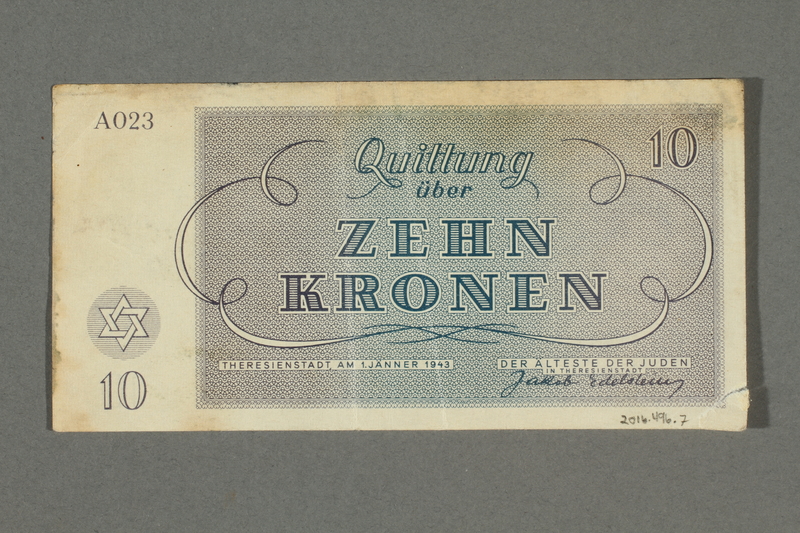Overview
- Brief Narrative
- Scrip, valued at 10 kronen, distributed to Heinz Frankenstein (later Henry Frank) in Theresienstadt ghetto-labor camp in German-occupied Czechoslovakia between January 1943 and May 1945. At Theresienstadt, currency was confiscated from inmates and replaced with scrip, which could only be used in the camp. The scrip was part of an elaborate illusion to make the camp seem normal and appear as though workers were being paid for their labor, but the money had no real monetary value. Heinz, his mother, and two of his sisters were deported from Berlin to Theresienstadt ghetto-labor camp in June 1942. In 1943, Heinz was among 250 young men deported to Wulkow near Berlin for a work detail. After a year, Heinz returned to the ghetto to find that his mother and sisters were gone; all but one of his sisters was deported to and killed at Auschwitz. Heinz was then deported to a camp near the town of Hof in Germany for a month, before being force marched back to Theresienstadt. He reunited with his sister, Inge, and they were liberated by the Soviet army on May 9. Heinz and Inge went to Deggendorf displaced persons (DP) camp in the American-occupied zone of Germany in June 1945. Heinz immigrated to the United States in June 1946, and changed his name to Henry Frank. Henry belonged to a social circle with other Holocaust survivors, including Irene Silberstein, who he married in April 1948. They had two children and regularly gave talks about their experiences during the Holocaust.
- Date
-
issue:
1943 January 01
use: 1943 January 01-1945 May 09
- Geography
-
issue:
Theresienstadt (Concentration camp);
Terezin (Ustecky kraj, Czech Republic)
- Credit Line
- United States Holocaust Memorial Museum Collection, Gift of Irene Frank
- Markings
- face, center, printed, navy blue ink : QUITTUNG ÜBER / ZEHN KRONEN / 10 / WER DIESE QUITTUNG VERFÄLSCHT ODER NACHMACHT / ODER GEFÄLSCHTE QUITTUNGEN IN VERKEHR BRINGT, / WIRD STRENGSTENS BESTRAFT. [RECEIPT OF / TEN CROWNS / 10 / ANYONE WHO FALSIFIES OR DISTORTS OR FAKES THIS RECEIPT, OR COUNTERFEITS RECEIPT, WILL BE STRICTLY PUNISHED]
face, lower right corner, printed, navy blue ink : 10
reverse, upper left corner, plate letter and number, printed, navy blue ink : A023
reverse, upper right and lower left corners, printed, navy blue ink : 10
reverse, center, printed, navy blue ink : Quittung / über / ZEHN KRONEN / THERESIENSTADT, AM 1.JÄNNER 1943 DER ALTESTE DER JUDEN / IN THERESIENSTADT / Jakob Edelstein [Receipt / of / TEN CROWNS / THERESIENSTADT, ON 1. JANUARY 1943 THE ELDER OF THE JEWS IN THERESIENSTADT Jakob Edelstein] - Contributor
-
Subject:
Henry Frank
Designer: Peter Kien
Printer: National Bank of Prague
Issuer: Der Alteste der Juden in Theresienstadt
- Biography
-
Henry Frank (1918-2002) was born Heinz Frankenstein in Berlin, Germany to Jakob (1888-1942) and Anna (nee Zydower, 1891-1944) Frankenstein. Heinz had four sisters: Dorothea (later Jastrow, 1914-1977), Irene (later Gratz, 1915-1944), Gerda (later Anschel, 1916-1942), and Inge (1925-1997). Jakob was injured fighting for Germany in World War I. He earned the Iron Cross for his service, but illness combined with his injuries made it difficult for him to work afterwards. As a result, the family was poor, and Anna had to work cleaning graves in a Jewish cemetery. As a child, Heinz was artistic and played the accordion and violin. The family was not very religious, but celebrated the major Jewish holidays. They lived in a mixed-religion neighborhood, and had many Gentile friends. Heinz always identified more strongly as German than Jewish, and never experienced antisemitism until 1933.
On January 30, 1933, Adolf Hitler was appointed Chancellor of Germany. Anti-Jewish decrees were passed that restricted every aspect of Jewish life. Heinz was forced to leave his public school, and he and his sisters began working to help support the family. He worked carrying coal in his neighborhood and later in a war supplies factory. In September 1939, in accordance with the Molotov Ribbentrop Pact, Germany and Russia invaded Poland. In response, Britain and France declared war on Germany. Heinz’s sister, Dorothea, her husband, and two children had fled for England earlier that summer, but the rest of the family were unable to leave Berlin. In April 1942, Gerda and her family were deported to the Warsaw Ghetto, and then to the Baltic region, where they were killed. Following the assassination attempt on General Reinhard Heydrich in Prague on May 27, 1942, Jakob was among 50 Jewish men who were rounded up in Berlin by the Gestapo. Jakob and the other men were transported to Sachsenhausen concentration camp, lined up against a brick wall, and shot. Within the week, unaware of their father’s fate, Heinz, Inge, Irene, and Anna were deported to Theresienstadt ghetto-labor camp in German-occupied Czechoslovakia. Heinz was assigned to work as a men’s nurse in the ghetto hospital, and helped take care of patients’ daily needs. He was later transferred to work at a mental institution.
In 1944, Heinz was among a group of young men deported to Wulkow near Berlin to build barracks for the Gestapo. They were beaten by the SS and promised that their good behavior would save their relatives in Theresienstadt from transport to the East. Irene had gotten sick and was deported to Auschwitz in October 1944. Anna volunteered to go along with her. A few days later, Inge was given permission to follow her mother, but by the time she arrived, Anna and Irene had been killed in the gas chambers. On October 27, Inge was deported to Oederan, a subcamp of Flossenbürg, where she was a forced laborer in a munitions factory. After a year in Wulkow, Heinz returned to Theresienstadt to find that his mother and sisters were gone.
After four weeks in Theresienstadt, Heinz was deported to a camp near the town of Hof in Germany, where he renovated housing. After a month, Heinz and a group of nearly 200 prisoners were force-marched six days and nights back to Theresienstadt. Many people died on the march, but the group arrived on April 20, 1945. There, Heinz reunited with his sister, Inge—whose shaved head and dirty appearance made her unrecognizable—the following day. She was transported there following the evacuation of Oederan on April 14. Theresienstadt was liberated by the Soviet army on May 9, but a Typhus epidemic prevented Heinz and Inge from leaving immediately after liberation. Once he could leave, Heinz traveled to Berlin to find his mother, unaware she had died in Auschwitz. He returned to his sister in Theresienstadt, and they were picked up by the American army and taken to Deggendorf displaced persons (DP) camp. On the way, the trucks were involved in an accident, leaving Heinz with broken ribs and a short hospital stay.
Heinz and Inge arrived at Deggendorf in June 1945, and stayed there until June 1946, when he immigrated to the United States. After arriving in New York City, the American Joint Distribution Committee put the refugees up in the Hotel Marseilles, and Heinz changed his name to Henry Frank. He could not speak English at first, but got a job working as a machinist at a factory in White Plains, a short distance from the city. He later got a job working in wholesale meat distribution. While living in New York, Henry belonged to a social circle with other Holocaust survivors. Every couple of weeks they would go to the piers to meet the arriving ships, and every Sunday they would go to Coney Island. Among this circle was Irene Silberstein (b. 1927), who he had met briefly while in Deggendorf. Henry and Irene married in April 1948, went on to have two children, and moved to New Jersey. They regularly visited local schools and gave talks about their experiences during the Holocaust.
Inge remained in Deggendorf until September 1946, when she immigrated to England. She then joined her sister, Dorothea, who lived on a small farm in Scotland with her husband and children. Inge immigrated to the United States in November 1949. Later, Dorothea and her family also came to the United States.
Franz Peter Kien was born January 1, 1919, in Varnsdorf, Czechoslovakia (Czech Republic), to Leonard and Olga Frankl Kien. His father Leonard was born in 1886, in Varnsdorf, and was a member of the German-speaking Jewish population in the, the Sudetenalnd, which bordered Germany. Leonard was a textile manufacturer with his own factory. Peter’s mother Olga was born in 1898, in Bzenec, Austro-Hungary (Czech Republic), to Jewish parents. After 1929, the Kien family moved to Brno. Peter enrolled at the German Gymnasium, where he excelled at drawing, painting, and writing. In 1936, he graduated and moved to Prague to study at the Academy of Fine Arts. He also attended the Officina Pragensis, a private graphic design school run by a well-known Jewish artist, Hugo Steiner-Prag.
On September 29, 1938, Germany annexed the Sudetenland. On March 15, 1939, Germany invaded Prague and annexed the Bohemia and Moravia provinces of Czechoslovakia, ruled by a Reich Protector. Jews were banned from participation in government, businesses, and organization, including schools. Peter had to leave the Academy, but continued to study at the Officina Pragensis. He also taught at Vinohrady Synagogue. In September 1940, Peter married Ilse Stranska, who was born on May 9, 1915, in Pilsen, to Jewish parents.
In late September 1941, Reinhard Heydrich, the SS head of RSHA, Reich Main Security Office, became Reich Protector. Soon there were regular deportations of Jews to concentration camps. At the end of November, Theresienstadt concentration and transit camp near Prague got its first shipment of Jewish prisoners. On December 14, Peter was transported to Theresienstadt ghetto-labor camp. He was assigned to the technical department where he worked as a draftsman and designer alongside other artists, including Bedrich Fritta, Leo Haas, and Jiri Lauscher. On July 16, 1942, Peter’s wife Ilse arrived in the camp. On January 30, 1943, Peter’s parents Leonard and Olga were transported from Bzenec to Terezin. Peter was assigned major projects by the Jewish Council that administered the camp for the Germans, such as the scrip receipts used in place of money in the camp. He secretly documented the inmate’s daily life, creating portraits and other drawings, and wrote plays, poems, and an operatic libretto. On October 16, 1944, Peter’s wife Ilse and his parents Leonard and Olga were selected for deportation. Peter volunteered to go with them. Before leaving, Peter and his family were sent to Auschwitz concentration camp in German-occupied Poland. Peter survived the selection process, soon fell ill, likely with typhus, and died at age 25 in late October 1944. His wife and parents were killed at Auschwitz. Some of the work that Peter left with other prisoners or hid at Theresienstadt survived and has been exhibited worldwide.
Physical Details
- Classification
-
Exchange Media
- Category
-
Money
- Object Type
-
Scrip (aat)
- Genre/Form
- Money.
- Physical Description
- Theresienstadt scrip printed on rectangular, off-white paper in navy blue ink. On the face is a rectangle with geometric patterning and a wide, off-white margin to the right. On the left, within the rectangle, is a vignette with an image of Moses holding 2 stone tablets inscribed with the 10 Commandments in Hebrew. To his right, is the denomination centered between lines of German text. In the lower right corner is a Star of David with the denomination below. The reverse has a rectangle with geometric patterning and a wide, off-white margin to the left. Within the rectangle is a central light blue streak, German text above and below a scrollwork line, the denomination on the upper right, and signature on the lower right. In the lower left corner is the denomination below a Star of David in a striped circle. The plate letter and number are in the upper left corner. The paper is worn with brown staining along the top and right edges. There are creases at the center and the corners are folded, the bottom left corner is partially torn.
- Dimensions
- overall: Height: 2.500 inches (6.35 cm) | Width: 5.000 inches (12.7 cm)
- Materials
- overall : paper, ink
Rights & Restrictions
- Conditions on Access
- No restrictions on access
- Conditions on Use
- No restrictions on use
Keywords & Subjects
- Topical Term
- Antisemitism--Germany. Death marches. Death march survivors. Displaced Persons Operations of the United Nations Relief and Rehabilitation Administration. Families. Forced labor--Germany. Holocaust, Jewish (1939-1945)--Czech Republic--Terezín (Ústecký kraj) Holocaust, Jewish (1939-1945)--Germany. Holocaust survivors--Marriage. Jewish ghettos--Economic aspects. Jews--Legal status, laws, etc.--Germany. Paper money--Czech Republic--Terezín (Ústecký kraj) Paper money--Germany--History. World War, 1939-1945--Civilian relief--Germany--Deggendorf. World War, 1939-1945--Concentration camps--Liberation. World War, 1939-1945--Refugees--Germany--Deggendorf.
Administrative Notes
- Legal Status
- Permanent Collection
- Provenance
- The scrip was donated to the United States Holocaust Memorial Museum in 2016 by Irene Frank.
- Record last modified:
- 2023-09-22 10:47:43
- This page:
- https://collections.ushmm.org/search/catalog/irn561081
Download & Licensing
In-Person Research
- By Appointment
- Request 21 Days in Advance of Visit
- Plan a Research Visit
- Request to See This Object
Contact Us
Also in Irene and Henry Frank family collection
The collection consists of patches, scrip, stamps, correspondence, documents, and photographs relating to the experiences of Henry and Irene Silberstein Frank and their relatives in Germany, Czechoslovakia, and Poland before and during the Holocaust, and in Germany and the United States after World War II.
Date: 1930-1992

Irene and Henry Frank papers
Document
The Irene and Henry Frank papers include correspondence, biographical materials, photographs, and Theresienstadt and Deggendorf materials documenting Irene and Henry Frank from Berlin, their survival in concentration and labor camps during the Holocaust, and their immigration to the United States in 1946. Correspondence primarily consists of messages from Henry’s mother, Anna, in Theresienstadt that were delivered to Henry at the Wulkow labor camp when supplies were delivered from Theresienstadt to Wulkow. Additional messages from Theresienstadt to Henry at Wulkow come from his sister, Inge, and his friends. The collection also includes a postwar letter from Dorothea Schonberg in Glasgow to Fritz Silberstein in Theresienstadt long after he had been transferred to Auschwitz and killed. Deggendorf materials include a photograph of a performance at the Deggendorf displaced persons camp, a torn tickets to an event at Deggendorf, and a picture postcard of Deggendorf. Henry Frank biographical materials include identification papers, certificates, and ration cards documenting his internment at Theresienstadt, postwar stay at the Deggendorf displaced persons camp, and immigration to the United States. Many of the records have adhesive and backing paper attached to them as they appear to have been removed from a scrapbook. Irene Frank biographical materials include identification papers documenting her status as a displaced person and victim of the Holocaust and a ticket documenting her immigration to the United States. Photographs depict Irene Frank’s arrival in New York aboard the SS Marine Perch, Theresienstadt, Deggendorf, and Holocaust memorials. Printed materials include 1975 and 1991 Theresienstadt reunion programs, a 1992 article describing Henry Frank’s Holocaust experiences, and clippings about Auschwitz. Belsora Silberstein biographical materials include her 1939 ID, 1946 displaced persons camp ID, and a vaccination card. The collection also includes picture postcards of Theresienstadt, many of which bear evidence of having been pasted into a scrapbook.
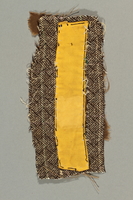
Yellow, rectangular patch on cloth backing worn by a German Jewish woman in a concentration camp
Object
Rectangular, yellow patch worn by Irene Silberstein while imprisoned at the forced labor camp Merzdorf from December 1944 to May 1945. Irene had to sew it to her outerwear, cutting out the brown tweed from behind. This served as a deterrent for escaping; if she tried to remove it from her clothes, the cut out would be visible and she would be easily recognizable. In the fall of 1942, Irene, her father, and her grandmother were deported from Berlin to Theresienstadt ghetto-labor camp in German-occupied Czechoslovakia. On September 28, 1944, Irene’s father was deported to Auschwitz-Birkenau. Irene was deported there the following week, but her father had already been killed in the gas chambers. In early December, she was forced on a transport to Merzdorf in Poland. She worked in a linen mill, processing, spinning, and weaving flax. Irene was able to wrap some of the flax around her legs for extra warmth and eat some of the seeds when no one was looking. At night, they had to unload coal from trains, resulting in 16-hour workdays. Merzdorf was liberated by the Soviet army on May 8, 1945 and Irene made her way back to Berlin. After learning her grandmother had survived, Irene traveled to Deggendorf displaced persons (DP) camp, arriving in March 1946, the day after her grandmother left for Sweden. After a week in Deggendorf, she registered for passage to America, and arrived in New York on May 24, 1946.
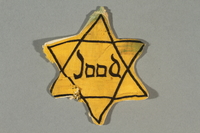
Factory-printed Star of David badge printed with Jood worn by a Jewish person
Object
Factory-printed Star of David badge, owned by a Jewish person in the Netherlands. Germany invaded the Netherlands in May 1940. On April 29, 1942, all Jews in the Netherlands were required to wear a badge, which consisted of a yellow Star of David with a black outline and the word “Jew” printed inside the star in Dutch. The badge was used to stigmatize and control the Jewish population. Duplicated from those printed in Germany, these badges were made by factories such as De Nijverheid, a formerly Jewish-owned firm in the Netherlands that printed a large amount of Dutch stars. In the summer of 1942, German officials began deporting Jews from the Netherlands—primarily from Westerbork transit camp—to Auschwitz in German-occupied Poland. Although a number of Jews went into hiding with the assistance of the Dutch underground, less than 25 percent of Jews from the Netherlands survived the Holocaust.
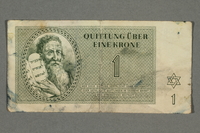
Theresienstadt ghetto-labor camp scrip, 1 krone note, belonging to a German Jewish inmate
Object
Scrip, valued at 1 krone, distributed to Heinz Frankenstein (later Henry Frank) in Theresienstadt ghetto-labor camp in German-occupied Czechoslovakia between January 1943 and May 1945. At Theresienstadt, currency was confiscated from inmates and replaced with scrip, which could only be used in the camp. The scrip was part of an elaborate illusion to make the camp seem normal and appear as though workers were being paid for their labor, but the money had no real monetary value. Heinz, his mother, and two of his sisters were deported from Berlin to Theresienstadt ghetto-labor camp in June 1942. In 1943, Heinz was among 250 young men deported to Wulkow near Berlin for a work detail. After a year, Heinz returned to the ghetto to find that his mother and sisters were gone; all but one of his sisters was deported to and killed at Auschwitz. Heinz was then deported to a camp near the town of Hof in Germany for a month, before being force marched back to Theresienstadt. He reunited with his sister, Inge, and they were liberated by the Soviet army on May 9. Heinz and Inge went to Deggendorf displaced persons (DP) camp in the American-occupied zone of Germany in June 1945. Heinz immigrated to the United States in June 1946, and changed his name to Henry Frank. Henry belonged to a social circle with other Holocaust survivors, including Irene Silberstein, who he married in April 1948. They had two children and regularly gave talks about their experiences during the Holocaust.
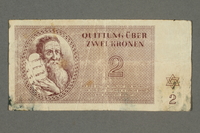
Theresienstadt ghetto-labor camp scrip, 2 kronen note, belonging to a German Jewish inmate
Object
Scrip, valued at 2 kronen, distributed to Heinz Frankenstein (later Henry Frank) in Theresienstadt ghetto-labor camp in German-occupied Czechoslovakia between January 1943 and May 1945. At Theresienstadt, currency was confiscated from inmates and replaced with scrip, which could only be used in the camp. The scrip was part of an elaborate illusion to make the camp seem normal and appear as though workers were being paid for their labor, but the money had no real monetary value. Heinz, his mother, and two of his sisters were deported from Berlin to Theresienstadt ghetto-labor camp in June 1942. In 1943, Heinz was among 250 young men deported to Wulkow near Berlin for a work detail. After a year, Heinz returned to the ghetto to find that his mother and sisters were gone; all but one of his sisters was deported to and killed at Auschwitz. Heinz was then deported to a camp near the town of Hof in Germany for a month, before being force marched back to Theresienstadt. He reunited with his sister, Inge, and they were liberated by the Soviet army on May 9. Heinz and Inge went to Deggendorf displaced persons (DP) camp in the American-occupied zone of Germany in June 1945. Heinz immigrated to the United States in June 1946, and changed his name to Henry Frank. Henry belonged to a social circle with other Holocaust survivors, including Irene Silberstein, who he married in April 1948. They had two children and regularly gave talks about their experiences during the Holocaust.
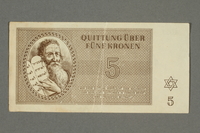
Theresienstadt ghetto-labor camp scrip, 5 kronen note, belonging to a German Jewish inmate
Object
Scrip, valued at 5 kronen, distributed to Heinz Frankenstein (later Henry Frank) in Theresienstadt ghetto-labor camp in German-occupied Czechoslovakia between January 1943 and May 1945. At Theresienstadt, currency was confiscated from inmates and replaced with scrip, which could only be used in the camp. The scrip was part of an elaborate illusion to make the camp seem normal and appear as though workers were being paid for their labor, but the money had no real monetary value. Heinz, his mother, and two of his sisters were deported from Berlin to Theresienstadt ghetto-labor camp in June 1942. In 1943, Heinz was among 250 young men deported to Wulkow near Berlin for a work detail. After a year, Heinz returned to the ghetto to find that his mother and sisters were gone; all but one of his sisters was deported to and killed at Auschwitz. Heinz was then deported to a camp near the town of Hof in Germany for a month, before being force marched back to Theresienstadt. He reunited with his sister, Inge, and they were liberated by the Soviet army on May 9. Heinz and Inge went to Deggendorf displaced persons (DP) camp in the American-occupied zone of Germany in June 1945. Heinz immigrated to the United States in June 1946, and changed his name to Henry Frank. Henry belonged to a social circle with other Holocaust survivors, including Irene Silberstein, who he married in April 1948. They had two children and regularly gave talks about their experiences during the Holocaust.
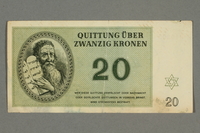
Theresienstadt ghetto-labor camp scrip, 20 kronen note, belonging to a German Jewish inmate
Object
Scrip, valued at 20 kronen, distributed to Heinz Frankenstein (later Henry Frank) in Theresienstadt ghetto-labor camp in German-occupied Czechoslovakia between January 1943 and May 1945. At Theresienstadt, currency was confiscated from inmates and replaced with scrip, which could only be used in the camp. The scrip was part of an elaborate illusion to make the camp seem normal and appear as though workers were being paid for their labor, but the money had no real monetary value. Heinz, his mother, and two of his sisters were deported from Berlin to Theresienstadt ghetto-labor camp in June 1942. In 1943, Heinz was among 250 young men deported to Wulkow near Berlin for a work detail. After a year, Heinz returned to the ghetto to find that his mother and sisters were gone; all but one of his sisters was deported to and killed at Auschwitz. Heinz was then deported to a camp near the town of Hof in Germany for a month, before being force marched back to Theresienstadt. He reunited with his sister, Inge, and they were liberated by the Soviet army on May 9. Heinz and Inge went to Deggendorf displaced persons (DP) camp in the American-occupied zone of Germany in June 1945. Heinz immigrated to the United States in June 1946, and changed his name to Henry Frank. Henry belonged to a social circle with other Holocaust survivors, including Irene Silberstein, who he married in April 1948. They had two children and regularly gave talks about their experiences during the Holocaust.
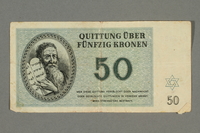
Theresienstadt ghetto-labor camp scrip, 50 kronen note, belonging to a German Jewish inmate
Object
Scrip, valued at 50 kronen, distributed to Heinz Frankenstein (later Henry Frank) in Theresienstadt ghetto-labor camp in German-occupied Czechoslovakia between January 1943 and May 1945. At Theresienstadt, currency was confiscated from inmates and replaced with scrip, which could only be used in the camp. The scrip was part of an elaborate illusion to make the camp seem normal and appear as though workers were being paid for their labor, but the money had no real monetary value. Heinz, his mother, and two of his sisters were deported from Berlin to Theresienstadt ghetto-labor camp in June 1942. In 1943, Heinz was among 250 young men deported to Wulkow near Berlin for a work detail. After a year, Heinz returned to the ghetto to find that his mother and sisters were gone; all but one of his sisters was deported to and killed at Auschwitz. Heinz was then deported to a camp near the town of Hof in Germany for a month, before being force marched back to Theresienstadt. He reunited with his sister, Inge, and they were liberated by the Soviet army on May 9. Heinz and Inge went to Deggendorf displaced persons (DP) camp in the American-occupied zone of Germany in June 1945. Heinz immigrated to the United States in June 1946, and changed his name to Henry Frank. Henry belonged to a social circle with other Holocaust survivors, including Irene Silberstein, who he married in April 1948. They had two children and regularly gave talks about their experiences during the Holocaust.
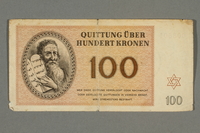
Theresienstadt ghetto-labor camp scrip, 100 kronen note, belonging to a German Jewish inmate
Object
Scrip, valued at 100 kronen, distributed to Heinz Frankenstein (later Henry Frank) in Theresienstadt ghetto-labor camp in German-occupied Czechoslovakia between January 1943 and May 1945. At Theresienstadt, currency was confiscated from inmates and replaced with scrip, which could only be used in the camp. The scrip was part of an elaborate illusion to make the camp seem normal and appear as though workers were being paid for their labor, but the money had no real monetary value. Heinz, his mother, and two of his sisters were deported from Berlin to Theresienstadt ghetto-labor camp in June 1942. In 1943, Heinz was among 250 young men deported to Wulkow near Berlin for a work detail. After a year, Heinz returned to the ghetto to find that his mother and sisters were gone; all but one of his sisters was deported to and killed at Auschwitz. Heinz was then deported to a camp near the town of Hof in Germany for a month, before being force marched back to Theresienstadt. He reunited with his sister, Inge, and they were liberated by the Soviet army on May 9. Heinz and Inge went to Deggendorf displaced persons (DP) camp in the American-occupied zone of Germany in June 1945. Heinz immigrated to the United States in June 1946, and changed his name to Henry Frank. Henry belonged to a social circle with other Holocaust survivors, including Irene Silberstein, who he married in April 1948. They had two children and regularly gave talks about their experiences during the Holocaust.
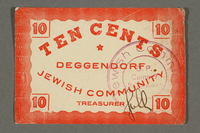
Deggendorf displaced persons camp scrip, 10-cent note, acquired by a former German Jewish prisoner
Object
Scrip, valued at 10 cents, distributed to Heinz Frankenstein while he lived in the Deggendorf displaced persons (DP) camp after World War II. Heinz, his mother, and two of his sisters were deported from Berlin to Theresienstadt ghetto-labor camp in June 1942. In 1943, Heinz was among 250 young men deported to Wulkow near Berlin for a work detail. After a year, Heinz returned to the ghetto to find that his mother and sisters were gone; all but one of his sisters was deported to and killed at Auschwitz. Heinz was then deported to the town of Hof in Germany for a month, before being force marched back to Theresienstadt. He reunited with his sister, Inge, and they were liberated by the Soviet army on May 9. Heinz and Inge went to Deggendorf DP camp in the American-occupied zone of Germany in June 1945. On August 23, 1945, the United Nations Relief and Rehabilitation Administration (UNRRA) Team 55 took over management of the poorly run camp. They stabilized the food supply, secured housing facilities, established a community newspaper, and fostered a cultural life with lectures, concerts, and performances. The camp administration introduced currency, set up a banking system, and established a canteen to purchase items. These amenities provided Heinz with a comfortable life until the quota system allowed him to depart Deggendorf for the United States in June 1946, and changed his name to Henry Frank. Henry belonged to a social circle with other Holocaust survivors, including Irene Silberstein, who he married in April 1948. They had two children and regularly gave talks about their experiences during the Holocaust.
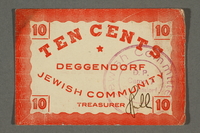
Deggendorf displaced persons camp scrip, 10-cent note, acquired by a former German Jewish prisoner
Object
Scrip, valued at 10 cents, distributed to Heinz Frankenstein while he lived in the Deggendorf displaced persons (DP) camp after World War II. Heinz, his mother, and two of his sisters were deported from Berlin to Theresienstadt ghetto-labor camp in June 1942. In 1943, Heinz was among 250 young men deported to Wulkow near Berlin for a work detail. After a year, Heinz returned to the ghetto to find that his mother and sisters were gone; all but one of his sisters was deported to and killed at Auschwitz. Heinz was then deported to the town of Hof in Germany for a month, before being force marched back to Theresienstadt. He reunited with his sister, Inge, and they were liberated by the Soviet army on May 9. Heinz and Inge went to Deggendorf DP camp in the American-occupied zone of Germany in June 1945. On August 23, 1945, the United Nations Relief and Rehabilitation Administration (UNRRA) Team 55 took over management of the poorly run camp. They stabilized the food supply, secured housing facilities, established a community newspaper, and fostered a cultural life with lectures, concerts, and performances. The camp administration introduced currency, set up a banking system, and established a canteen to purchase items. These amenities provided Heinz with a comfortable life until the quota system allowed him to depart Deggendorf for the United States in June 1946, and changed his name to Henry Frank. Henry belonged to a social circle with other Holocaust survivors, including Irene Silberstein, who he married in April 1948. They had two children and regularly gave talks about their experiences during the Holocaust.
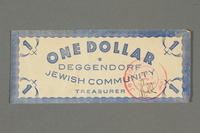
Deggendorf displaced persons camp scrip, 1 dollar note, acquired by a former German Jewish prisoner
Object
Scrip, valued at 1 dollar, distributed to Heinz Frankenstein while he lived in the Deggendorf displaced persons (DP) camp after World War II. Heinz, his mother, and two of his sisters were deported from Berlin to Theresienstadt ghetto-labor camp in June 1942. In 1943, Heinz was among 250 young men deported to Wulkow near Berlin for a work detail. After a year, Heinz returned to the ghetto to find that his mother and sisters were gone; all but one of his sisters was deported to and killed at Auschwitz. Heinz was then deported to the town of Hof in Germany for a month, before being force marched back to Theresienstadt. He reunited with his sister, Inge, and they were liberated by the Soviet army on May 9. Heinz and Inge went to Deggendorf DP camp in the American-occupied zone of Germany in June 1945. On August 23, 1945, the United Nations Relief and Rehabilitation Administration (UNRRA) Team 55 took over management of the poorly run camp. They stabilized the food supply, secured housing facilities, established a community newspaper, and fostered a cultural life with lectures, concerts, and performances. The camp administration introduced currency, set up a banking system, and established a canteen to purchase items. These amenities provided Heinz with a comfortable life until the quota system allowed him to depart Deggendorf for the United States in June 1946, and changed his name to Henry Frank. Henry belonged to a social circle with other Holocaust survivors, including Irene Silberstein, who he married in April 1948. They had two children and regularly gave talks about their experiences during the Holocaust.
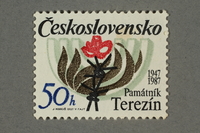
Czechoslovakian commemorative Theresienstadt Memorial postage stamp, 50h, acquired by a former German Jewish inmate
Object
Postage stamp commemorating the 40th anniversary of the Terezin (Theresienstadt) Ghetto Memorial, acquired by Irene Silberstein Frank and Henry Frank, former inmates of Theresienstadt ghetto-labor camp in German-occupied Czechoslovakia. Originally called the National Suffering Memorial, it was established in 1947 by the newly reinstated Czechoslovakian government and was renovated in 1975. The stamp depicts the large, granite, 7-branched menorah in the Jewish cemetery outside the crematorium building, along with flames, the red flowers planted in the 1945 National Cemetery, and barbed wire used to surround the ghetto. Henry, his mother, and two of his sisters were deported from Berlin to Theresienstadt in June 1942. He was deported on multiple work details before returning to the ghetto, where he reunited with his sister, Inge. Heinz and Inge were liberated by the Soviet army on May 9 1945. Irene, her father, and her grandmother were deported from Berlin to Theresienstadt in the fall of 1942. In December 1944, she was deported to Poland as a forced laborer until she was liberated by the Soviet army on May 8, 1945. After the war, Henry and Irene briefly met in Deggendorf displaced persons camp, and then again in New York City, where they belonged to the same social circle. The couple married in April 1948, had two children, and regularly gave talks about their experiences during the Holocaust. In 1975, they attended a reunion commemorating the 30th anniversary of Theresienstadt’s liberation, and in 1991 attended a meeting commemorating the 50th anniversary of the ghetto-labor camp’s establishment.
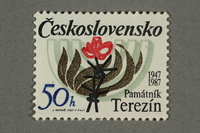
Czechoslovakian commemorative Theresienstadt Memorial postage stamp, 50h, acquired by a former German Jewish inmate
Object
Postage stamp commemorating the 40th anniversary of the Terezin (Theresienstadt) Ghetto Memorial, acquired by Irene Silberstein Frank and Henry Frank, former inmates of Theresienstadt ghetto-labor camp in German-occupied Czechoslovakia. Originally called the National Suffering Memorial, it was established in 1947 by the newly reinstated Czechoslovakian government and was renovated in 1975. The stamp depicts the large, granite, 7-branched menorah in the Jewish cemetery outside the crematorium building, along with flames, the red flowers planted in the 1945 National Cemetery, and barbed wire used to surround the ghetto. Henry, his mother, and two of his sisters were deported from Berlin to Theresienstadt in June 1942. He was deported on multiple work details before returning to the ghetto, where he reunited with his sister, Inge. Heinz and Inge were liberated by the Soviet army on May 9 1945. Irene, her father, and her grandmother were deported from Berlin to Theresienstadt in the fall of 1942. In December 1944, she was deported to Poland as a forced laborer until she was liberated by the Soviet army on May 8, 1945. After the war, Henry and Irene briefly met in Deggendorf displaced persons camp, and then again in New York City, where they belonged to the same social circle. The couple married in April 1948, had two children, and regularly gave talks about their experiences during the Holocaust. In 1975, they attended a reunion commemorating the 30th anniversary of Theresienstadt’s liberation, and in 1991 attended a meeting commemorating the 50th anniversary of the ghetto-labor camp’s establishment.
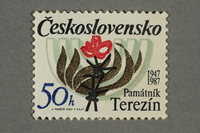
Czechoslovakian commemorative Theresienstadt Memorial postage stamp, 50h, acquired by a former German Jewish inmate
Object
Postage stamp commemorating the 40th anniversary of the Terezin (Theresienstadt) Ghetto Memorial, acquired by Irene Silberstein Frank and Henry Frank, former inmates of Theresienstadt ghetto-labor camp in German-occupied Czechoslovakia. Originally called the National Suffering Memorial, it was established in 1947 by the newly reinstated Czechoslovakian government and was renovated in 1975. The stamp depicts the large, granite, 7-branched menorah in the Jewish cemetery outside the crematorium building, along with flames, the red flowers planted in the 1945 National Cemetery, and barbed wire used to surround the ghetto. Henry, his mother, and two of his sisters were deported from Berlin to Theresienstadt in June 1942. He was deported on multiple work details before returning to the ghetto, where he reunited with his sister, Inge. Heinz and Inge were liberated by the Soviet army on May 9 1945. Irene, her father, and her grandmother were deported from Berlin to Theresienstadt in the fall of 1942. In December 1944, she was deported to Poland as a forced laborer until she was liberated by the Soviet army on May 8, 1945. After the war, Henry and Irene briefly met in Deggendorf displaced persons camp, and then again in New York City, where they belonged to the same social circle. The couple married in April 1948, had two children, and regularly gave talks about their experiences during the Holocaust. In 1975, they attended a reunion commemorating the 30th anniversary of Theresienstadt’s liberation, and in 1991 attended a meeting commemorating the 50th anniversary of the ghetto-labor camp’s establishment.
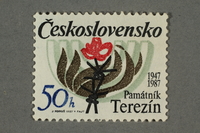
Czechoslovakian commemorative Theresienstadt Memorial postage stamp, 50h, acquired by a former German Jewish inmate
Object
Postage stamp commemorating the 40th anniversary of the Terezin (Theresienstadt) Ghetto Memorial, acquired by Irene Silberstein Frank and Henry Frank, former inmates of Theresienstadt ghetto-labor camp in German-occupied Czechoslovakia. Originally called the National Suffering Memorial, it was established in 1947 by the newly reinstated Czechoslovakian government and was renovated in 1975. The stamp depicts the large, granite, 7-branched menorah in the Jewish cemetery outside the crematorium building, along with flames, the red flowers planted in the 1945 National Cemetery, and barbed wire used to surround the ghetto. Henry, his mother, and two of his sisters were deported from Berlin to Theresienstadt in June 1942. He was deported on multiple work details before returning to the ghetto, where he reunited with his sister, Inge. Heinz and Inge were liberated by the Soviet army on May 9 1945. Irene, her father, and her grandmother were deported from Berlin to Theresienstadt in the fall of 1942. In December 1944, she was deported to Poland as a forced laborer until she was liberated by the Soviet army on May 8, 1945. After the war, Henry and Irene briefly met in Deggendorf displaced persons camp, and then again in New York City, where they belonged to the same social circle. The couple married in April 1948, had two children, and regularly gave talks about their experiences during the Holocaust. In 1975, they attended a reunion commemorating the 30th anniversary of Theresienstadt’s liberation, and in 1991 attended a meeting commemorating the 50th anniversary of the ghetto-labor camp’s establishment.
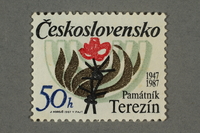
Czechoslovakian commemorative Theresienstadt Memorial postage stamp, 50h, acquired by a former German Jewish inmate
Object
Postage stamp commemorating the 40th anniversary of the Terezin (Theresienstadt) Ghetto Memorial, acquired by Irene Silberstein Frank and Henry Frank, former inmates of Theresienstadt ghetto-labor camp in German-occupied Czechoslovakia. Originally called the National Suffering Memorial, it was established in 1947 by the newly reinstated Czechoslovakian government and was renovated in 1975. The stamp depicts the large, granite, 7-branched menorah in the Jewish cemetery outside the crematorium building, along with flames, the red flowers planted in the 1945 National Cemetery, and barbed wire used to surround the ghetto. Henry, his mother, and two of his sisters were deported from Berlin to Theresienstadt in June 1942. He was deported on multiple work details before returning to the ghetto, where he reunited with his sister, Inge. Heinz and Inge were liberated by the Soviet army on May 9 1945. Irene, her father, and her grandmother were deported from Berlin to Theresienstadt in the fall of 1942. In December 1944, she was deported to Poland as a forced laborer until she was liberated by the Soviet army on May 8, 1945. After the war, Henry and Irene briefly met in Deggendorf displaced persons camp, and then again in New York City, where they belonged to the same social circle. The couple married in April 1948, had two children, and regularly gave talks about their experiences during the Holocaust. In 1975, they attended a reunion commemorating the 30th anniversary of Theresienstadt’s liberation, and in 1991 attended a meeting commemorating the 50th anniversary of the ghetto-labor camp’s establishment.
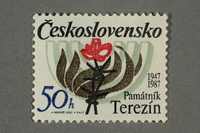
Czechoslovakian commemorative Theresienstadt Memorial postage stamp, 50h, acquired by a former German Jewish inmate
Object
Postage stamp commemorating the 40th anniversary of the Terezin (Theresienstadt) Ghetto Memorial, acquired by Irene Silberstein Frank and Henry Frank, former inmates of Theresienstadt ghetto-labor camp in German-occupied Czechoslovakia. Originally called the National Suffering Memorial, it was established in 1947 by the newly reinstated Czechoslovakian government and was renovated in 1975. The stamp depicts the large, granite, 7-branched menorah in the Jewish cemetery outside the crematorium building,along with flames, the red flowers planted in the 1945 National Cemetery, and barbed wire used to surround the ghetto. Henry, his mother, and two of his sisters were deported from Berlin to Theresienstadt in June 1942. He was deported on multiple work details before returning to the ghetto, where he reunited with his sister, Inge. Heinz and Inge were liberated by the Soviet army on May 9 1945. Irene, her father, and her grandmother were deported from Berlin to Theresienstadt in the fall of 1942. In December 1944, she was deported to Poland as a forced laborer until she was liberated by the Soviet army on May 8, 1945. After the war, Henry and Irene briefly met in Deggendorf displaced persons camp, and then again in New York City, where they belonged to the same social circle. The couple married in April 1948, had two children, and regularly gave talks about their experiences during the Holocaust. In 1975, they attended a reunion commemorating the 30th anniversary of Theresienstadt’s liberation, and in 1991 attended a meeting commemorating the 50th anniversary of the ghetto-labor camp’s establishment.


